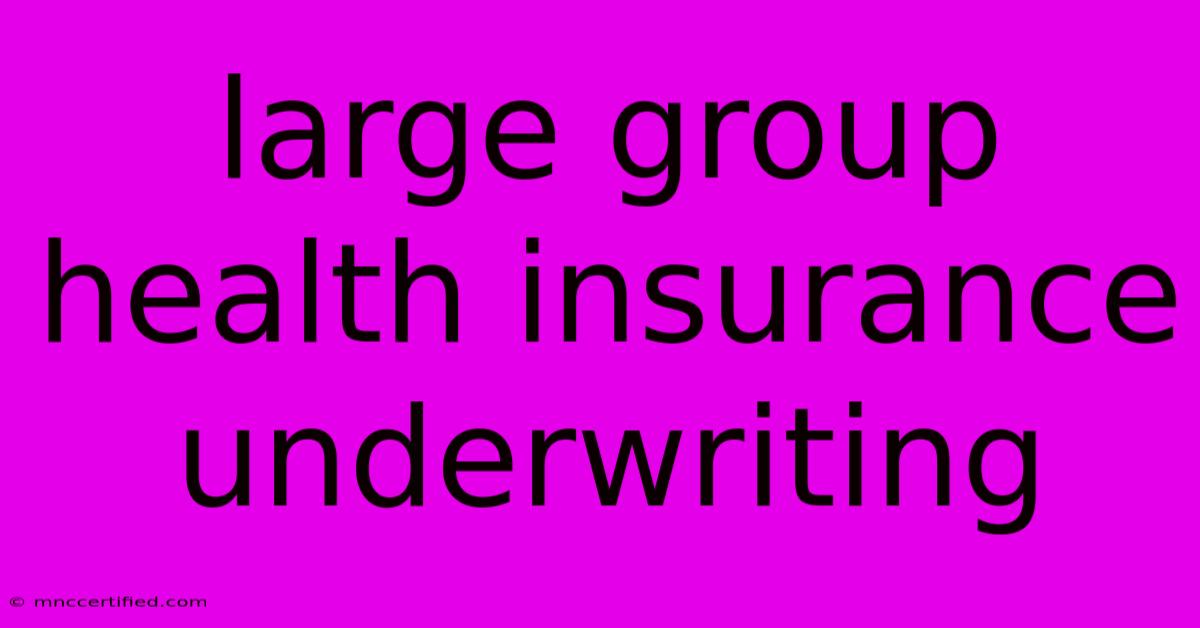Large Group Health Insurance Underwriting

Table of Contents
Navigating the Landscape of Large Group Health Insurance Underwriting
Securing health insurance for a large group, whether it's a company with hundreds of employees or a large organization, involves a complex process known as underwriting. This crucial step determines your group's eligibility for coverage and the premiums you'll pay. Understanding the ins and outs of large group health insurance underwriting empowers you to make informed decisions and secure the best possible plan for your needs.
Understanding the Basics
Large group health insurance underwriting differs significantly from individual plans. Instead of focusing solely on the health of individual applicants, insurers evaluate the entire group's risk profile. This involves considering factors like:
- Group size: The larger the group, the more predictable the risk pool becomes.
- Industry: Certain industries, like construction or manufacturing, often face higher risk profiles due to inherent hazards.
- Demographics: Factors like age, gender, and location can influence the overall health of the group.
- Claims history: Past claims data provides valuable insights into the group's health and potential future costs.
- Employee health initiatives: Programs promoting wellness and preventive care can positively impact the group's risk profile.
The Underwriting Process: A Detailed Look
The underwriting process for large groups typically involves these steps:
- Application and information gathering: The insurer requests detailed information about the group, including size, demographics, industry, and claims history.
- Risk assessment: The insurer analyzes the information provided and evaluates the group's overall risk profile.
- Premium determination: Based on the risk assessment, the insurer calculates the premiums for the group.
- Contract negotiation: The insurer and the group negotiate the terms of the insurance contract, including coverage details, exclusions, and premium payment schedule.
- Policy issuance: Once the contract is finalized, the insurer issues the policy, providing coverage to the group.
Key Considerations for Large Group Underwriting
1. Financial Stability: Insurers assess the group's financial stability to ensure the ability to pay premiums. This is especially important for smaller groups with limited financial resources.
2. Employee Health and Wellness: Promoting employee health and well-being is critical. Employers should invest in wellness programs, health screenings, and preventive care initiatives to minimize claims and improve the group's risk profile.
3. Transparency and Communication: Open communication with the insurer during the underwriting process is key. Sharing accurate and complete information ensures a smooth process and a fair assessment of the group's risk.
4. Comparison Shopping: Don't settle for the first offer you receive. Compare proposals from different insurers to secure the most competitive rates and comprehensive coverage.
Optimizing Your Underwriting Experience
1. Prepare Thoroughly: Gather all necessary information about your group, including detailed demographics, industry specifics, and claims history.
2. Engage in Proactive Risk Management: Implement employee health initiatives to improve well-being and minimize future claims.
3. Partner with a Broker: A knowledgeable insurance broker can navigate the complexities of underwriting and secure favorable terms for your group.
4. Negotiate Effectively: Don't hesitate to discuss your needs and priorities with the insurer. Be prepared to negotiate premiums and coverage details to achieve the best possible outcome.
Moving Forward: A Secure Future
Understanding the intricacies of large group health insurance underwriting empowers you to make informed decisions and secure the right coverage for your organization. By prioritizing transparency, financial stability, and employee wellness, you can navigate the underwriting process with confidence and achieve a secure future for your employees.

Thank you for visiting our website wich cover about Large Group Health Insurance Underwriting. We hope the information provided has been useful to you. Feel free to contact us if you have any questions or need further assistance. See you next time and dont miss to bookmark.
Featured Posts
-
How Bonds Ate The Entire Financial System
Nov 07, 2024
-
How To Start A Real Estate Investment Firm
Nov 07, 2024
-
Virginia Auto Insurance Rate Increase 2023
Nov 07, 2024
-
Trumps Party Wins Senate What Now
Nov 07, 2024
-
Biden Addresses Harriss Election Loss
Nov 07, 2024